Greetings!
This week’s excerpt sees the Lowlander and I go on an organised day trip. I don’t usually do organised trips and if you want reminding of why, revisit the account of our trip to the Great Wall, but this was one of the better ones. The key is usually the size of the group. Tours with less than ten in the group tend to be better. Later on when I post my travelogue ‘The Missing Link’, you’ll be able to read about one of the best organised day trips that I’ve ever taken, (and the most expensive), to Chernobyl and the radioactive city of Pripyat. But for now, things aren’t quite so buzzing, in fact, with a hell of a lot of big Buddhas around, you could almost say that they are meditative.
Keep travelling!
Uncle Travelling Matt
Links to all parts of the travelogue
Book 1: Embarking Upon A New Korea
1e: Seoul, Incheon and Across the Yellow Sea
Book 2: Master Potter does Fine China
Book 3: Steppe to the Left, Steppe to the Right…
25th July, 2002 – Lanzhou, China
We were up early again, this time due to the fact that we'd booked ourselves upon a tour of Bingling-si, or the 'Thousand Buddha Caves' the day before. Early we may have risen, but sadly not early enough, for by the time that we'd got ready, we found that we had not the time spare to grab some breakfast before heading off, which required a visit to the tasty yet expensive hotel restaurant. That completed, and with full bellies, we then sought out our minibus and departed at a time only ten minutes later than scheduled.
Our promised minibus turned out to be but a car and our fellow tourists, but a fellow Japanese gent named Mr. Endo, (a name that I remembered easily, since it is also the name of my favourite Japanese author). Endo-san turned out to be an interesting guy and a serious traveller. He was a student at Osaka University and two years ago had travelled to Portugal via China, Pakistan, Iran, Turkey and a number of other countries. This time his destination was Nepal, via Tibet of course, and his journey, like ours, was still in its early stages.
I was particularly looking forward to this trip. Not only did the Buddha Caves sound rather interesting, but this would be my first trip into the Chinese countryside. From what we'd seen so far, all of China's cities seemed to display an affluence above and beyond what we'd expected to find. Did that carry over to the rural areas however? Had the revolution helped the peasants from whence its father figure, Mao Tse Tung, had come?
Before hitting the fields however, we had to drive through the miles and miles of suburbs of the snake-like city of Lanzhou. Although not as rich as the centre, these areas were still well-off and the dual-carriageway upon which we travelled of excellent quality. The scene here however was more stereotypically socialist. The heavy industry of the Great Leap Forward had taken the place of the towers of commerce and the workers looked as workers should, dressed in grey or brown proletarian pyjama-type suits such as Mao made famous. Travelling through the area in the early morning was fascinating. In front of virtually every garage, factory, shop or restaurant, the staff were out doing their exercises in neat formation. I'd seen many examples of people doing gymnastics or tai chi in the parks of Beijing and Yinchuan, but all those had been voluntary and without a leader. These were more like what I'd encountered in Japan. Mandatory drills led by the fore(wo)man. A common sight in the Orient, unknown in Europe.
The countryside when it arrived, turned out to be hilly and arid, and reminded me somewhat of Albania or some of the drier parts of Greece. Unlike the stereotypes of China, there was no rice being grown here. Instead the fields were full of grain which was being harvested at the time that we passed through, resulting in rows of stooks evoking images of a bygone Europe rather than the Far East. In one village of mud-brick houses that we passed through, the peasants were stood in the road tossing the straw up into the air in an effort to sort it from the grain. The scene was one from fifty years ago, with ruddy-faced farm workers complete with straw hats and pitchforks, whilst wizened old men sat in the nearby doorways, playing go or majong, and surveying the proceedings with the eye of the wise.
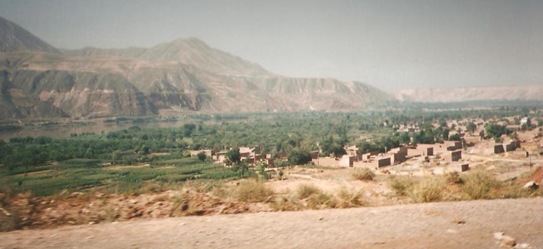 Countryside scene en-route to Bingling-si
Countryside scene en-route to Bingling-si
As we passed one village school I spied a large statue of Mao, arm outstretched, crumbling in the schoolyard. This surprised me somewhat since it was the first statue of the great leader that we'd seen outside of Beijing. The lack of statues or indeed any sort of socialist memorials had been puzzling us for sometime. Wherever one goes in Eastern Europe, the countryside is littered with statues of revolutionary heroes, dedications to the war dead and monuments to socialist progress. And that is after ten years of capitalism, during which countless monuments have been torn down by the people. Yet China has never had that ten years, nor any reason to rip down its images of People Power. Quite the opposite in fact, and so the question must be asked as to where are all those Mao statues and sculptures of socialism? The most probable answer is that they were never put up in the first place, which suggests that China's communism was perhaps taking a different form even before Deng Xiaoping came along, and that the personality cult of Mao was, (like most other things concerning the world behind the Bamboo and Iron Curtains), exaggerated out of all proportion by the Western media.
One thing that could not be denied however, is that the countryside has not benefitted from recent events as much as the towns, or at least, certainly not in the Gansu Province, (which incidentally is one of China's poorest). Nonetheless, the picture here is not entirely one of despair. Not once on this trip, nor indeed on any of the others that we took subsequently in China, did we see animals being used as beasts of burden, or examples of horse-drawn transportation, both common sights in the Third World and Eastern Europe. Even the poorest farmer seemed to possess a tiny three-wheel tractor or truck, and many more something far more substantial. What's more, all the houses had electricity, the stores were full and the vast majority of roads metalled. The only one that we travelled upon that wasn't was further on, nearer to Bingling-si. There our car twisted, turned, rumbled and stumbled over a dusty dirt track. But the reason for the terrible quality of that road was obvious; the normal one was being rebuilt, transformed into a well-engineered, wide highway. So well-engineered in fact that we initially thought that it was going to be railway line!
Our bumpy road ended abruptly in a small village by a huge dam. It was there that we were to transfer onto a speedboat for the next stage of our journey.
As the boat sped off I had a good look at our surroundings. They were spectacular, jagged cliffs rose up on either side of the calm yellow water, some topped with a small pagoda or flag. On others, large hotels were being built and it was obvious why. With scenery this fantastic, as well as the Buddha Caves and the proximity to Lanzhou with its airport, railway station and almost four million people, it was clear that a lot of money could be made here, out of the domestic tourist market alone, let alone foreigners. And the place was so huge that over fifty hotels could be built without impacting upon the beauty of the place at all. No doubt the new road was all part of the same masterplan. China's booming economy was creating a large domestic tourist market and Bingling Si was obviously being prepared to meet this new demand. Many people may criticize such developments, but if it helps China move forwards, then I'm happy for them.
Though I'm glad that we got there first.
The boat journey was longer than I'd expected, over an hour in fact. We sped first through the rocky gorges with their pagoda-topped cliffs and then into a huge lake that took an age to cross. After that, the river narrowed once more, with steep cliffs on either side and hemmed in by the riverside, tiny pastures were sheep were kept. The boat zigzagged across the waterway to avoid the shallows and rounded a corner to reveal the most spectacular rock formations that I have ever seen. Towering pillars of igneous rock loomed up by the riverside, threatening to topple down into the water at any moment and crush our tiny boat and its occupants. And then past the rocks, we saw the Buddha Caves of Bingling Si.
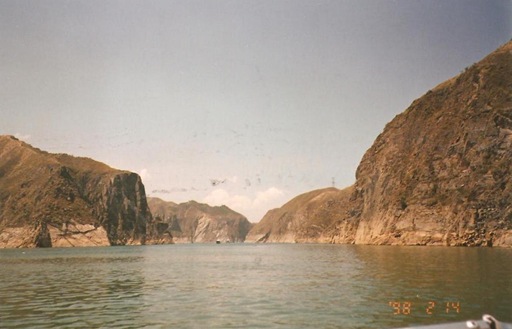 Taking a trip down the Yellow River
Taking a trip down the Yellow River
Just above the simple quay, a large building was under construction, no doubt to hold the restaurants and souvenir shops required when the site was fully developed for tour groups. At present however, all that catered for out touristic needs were a few humble stalls offering soft drinks and family heirlooms. Our time however, was limited so we bypassed these delights and walked on to the caves themselves.
The name 'Thousand Buddha Caves' is somewhat misleading in two respects, firstly in that the caves number little under two hundred, and not a thousand, and secondly in that the word 'cave' is something of an exaggeration, and the term 'niche' is perhaps far more apt. Nonetheless, the place was well worth the visit. Set into the rockside for countless niches, ranging in size from around twenty centimetres square, to small rooms in which several people could stand, and in each cave was a figure of the Buddha or another deity. The highlight however, was a little further on, one huge sitting Buddha, similar to the famous ones at Bamiyan, (though without the Taliban alterations). We sat beneath the mighty holy man's feet and marvelled at his size, and wondered how he'd managed to live through the Cultural Revolution in tact.
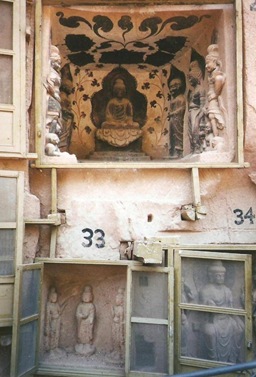
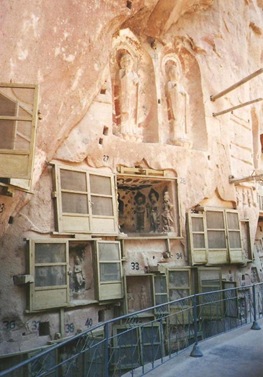 Some of the ‘Thousand Caves’ (or niches…)
Some of the ‘Thousand Caves’ (or niches…)
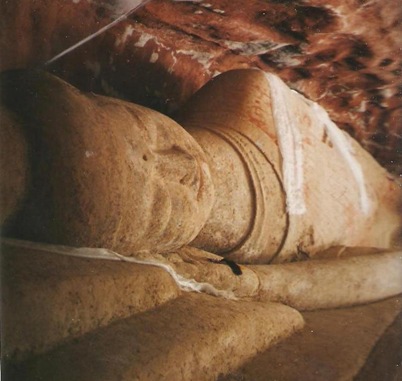 Exhausted by the visit of Uncle Travelling Matt, the great man takes a quick nap…
Exhausted by the visit of Uncle Travelling Matt, the great man takes a quick nap…
On the way back we stopped at some of the stalls and had a look at what they had to offer. A plate depicting Chairman Mao outside Tiananmen Gate caught my eye, and I haggled the guy down to Y20 (2.50 euros), and bought it. We then boarded the boat for the long trip home.
Back in Lanzhou we decided over lunch to try the city's other cable car which ran up the mountain on the opposite side of the valley of the one that we'd already ridden on. The only problem with that however, was finding a taxi driver who knew where it was. Despite drawing a picture of a cable car, saying it in Chinese and then showing him the characters that he learnt at school, we had no luck and in the end we got him to drop us off in the general area and we walked the rest ourselves.
The area in which the base station was situated was one of the poorest in town, and it seemed a world away from the flashy business district less than a kilometre to the north. Red brick slums jostled for space on the hillside whilst wizened crones hawked melons on the street. The was one area that had definitely been out for lunch during any Great Leap Forward.
We boarded the cable car, (which was actually a chair lift), and made our way slowly up the mountain as the lights came out. Looking down we were relieved to see that the poor area of town was tiny in relation to the rest and that the views over the city were spectacular. At the top we headed to a viewing platform adjacent to a huge temple bell, and there we sat drinking warm beer, (why can't the Chinese work out the concept of ice?), and playing some enthralling backgammon. However, with the score at two all we were eventually driven away by a party of drunk locals who found it amusing to continually ring the big bell, driving us back down the hill and gratefully into our beds.
Next part: 2i: Xiahe
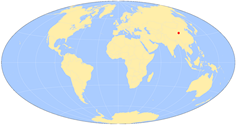


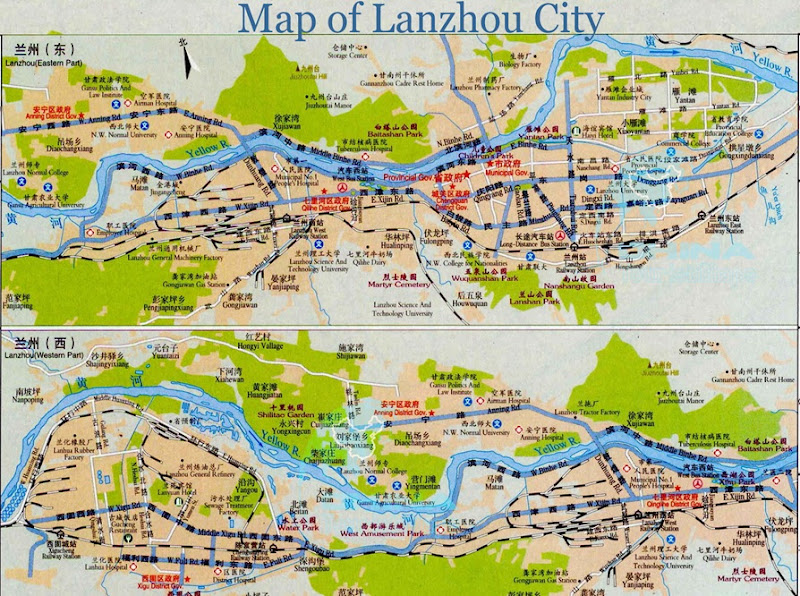
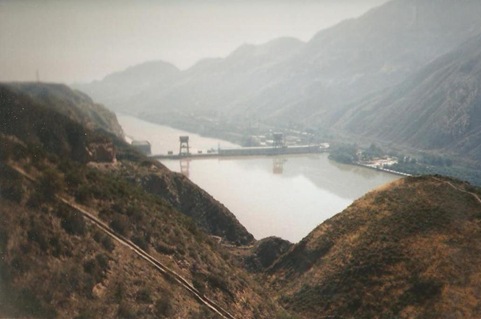
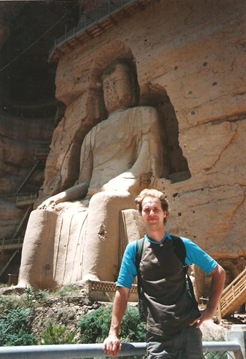
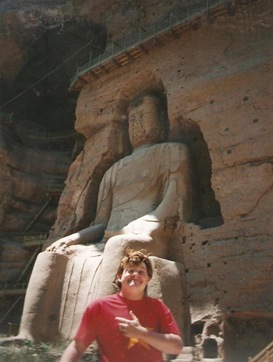
No comments:
Post a Comment